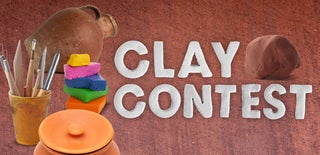Introduction: Model Magic 101: Finger Puppets
Model Magic is an air-dry clay made by Crayola. It's light and fluffy with no crumbly or sticky mess. I love to use it with my elementary students, but it's also great for costume props. I'll show some examples of props I've made with it in the last step. I'll outline the basics of how to use it and some useful tips and tricks I've picked up over the years.
Post 7/6 for the most options
Step 1: Purchasing
Model Magic can be obtained at just about any store that sells an assortment of Crayola products. It comes in a wide variety of colors and two primary sizes. There are large (8 oz) packages that are usually sold individually or bulk boxes and small (.5 oz ) packages that most often come in kits or teacher classroom packs.
I've purchased just about every type of color and package and have come to the conclusion that the small packages of white are the best way to go. With the large packages, I often found myself needing just a little bit more than what was in my last pack. Then there's the struggle of what to use the rest of the pack on when I'm finished with my current project, because it doesn't last in a baggie for very long after the initial package is opened. With smaller packs, it's just a little bit of waste when you have to open a new pack. I prefer the smaller packs, but I have some large packs leftover from before I discovered the versatility of the small packs, so that's what I'll be using for this instructable.
Yes, the purchased colors are fun and easy, but you'll have a lot of waste and spend a lot of money to get all the colors you need. I'm going to show you why white is the superior choice for both your personal projects and for students.
Step 2: Knead
While you're thinking about what to make, knead the clay until it stretches when you pull on it. It reacts somewhat like silly putty in that if you pull very quickly and sharply, it will most likely break instead of stretch, so pull slowly at first. The more you knead it, the faster you can pull without it tearing.
Always keep the clay moving or wrapped up in a baggie to avoid drying out. It must be wrapped tightly as any air in the bag can contribute to drying. Model Magic takes 24 hours or more to dry thoroughly depending on the thickness of the finished piece, but the outside layer is exposed to the air and begins to dry immediately upon being left stagnant. It will begin to form a "crust" on the outside and won't sick to itself as well.
Because of this relatively quick drying time, you should have a plan and a few baggies on hand to hold clay you aren't currently using. In my classroom, I often partner students to take turns being each other's assistant. One student works on their piece while their assistant makes sure their clay doesn't dry out by kneading it or wrapping up unused pieces.
Step 3: Color
Separate a piece of clay that you want to be one color. Flatten like a pancake in your hands. Avoid smashing on a table or other smooth surface. It resists sticking and will come off the table, but the shape you form on a surface will become misshapen when peeling it up.
Color the center of your pancake with a marker. Do not touch the colored area! The ink will get on your hands and can contaminate other pieces of clay when you move on to different colors.
Fold your pancake like a taco. You should not be able to see any of the marker.
Knead the clay and watch as the ink from the marker colors the clay without getting ink on your hands.
If the color isn't dark enough for you, repeat these steps. Pancake, color, taco, and knead.
Step 4: Custom Colors
Now the fun and educational part!
What if you add yellow to that blue clay you just made? What if you add red or green?
You can mix any color you want. Rich colors take more time, but it's usually worth the saved expense and added personal touch.
You can also use this process to teach or assess color theory with young learners. The clay will change as if by magic when other colors are mixed in. They get to actually see the colors mix and change before their eyes, and their amazement is priceless as they joyfully begin to understand color theory.
I've also used this as an assessment. After other exploratory color theory experiences and learning the primary and secondary colors, the students are given clay and an age appropriate selection of markers. I instruct them to make their clay a color using at least two colors of marker. (Kindergarten may only have primary colors while 3rd grade may have primary, secondary, and a few tertiary.) At the end of class, students with brown clay most likely need reteaching. Questioning the students on what color they were trying to make and what colors they used will help address misconceptions.
Step 5: Tools
When sculpting with model magic, you'll want scissors, a pointy tool like a stylus, and a flat tool.
Scissors are a must have tool for model magic. The model magic doesn't gum up the scissors and it is much easier to divide larger pieces of clay precisely. For my kindergarteners first experience mixing colors with model magic, I cut each .5 oz package in half when passing out pieces. This greatly reduced the amount of clay we were using for their first time using the clay, and it helped them get the packages open on their own. Back before I discovered the .5 oz packs, I used to cut the large 8 oz packs into pieces easily and quickly with scissors.
Step 6: Things to Consider Before Sculpting
The most important thing when sculpting with model magic is to work relatively quick. The top layer of the clay that is exposed to the air begins drying immediately upon being removed from the bag. If you continue to knead the clay, it will stay smooth and flexible.
If the outer layer of the clay is drying out, additional pieces of clay will not stick to it well. I have whole sculptures fall apart when drying because they were partially dry when stuck together. You can see in the images and notes above how it looks when the clay has partially dried. Two partially dry pieces of clay can be pulled apart easily and the areas where they were pressed together will be smooth. Pieces applied this way will most likely fall apart when you set the finished piece aside to dry completely. When two pieces are pressed together that are both "wet" they will not pull apart as easily or without transferring color from one piece to the other. There's no need to squish your pieces together firmly if your pieces are nice and "wet."
Be sure to return unused pieces of clay to the baggies so they won't dry out while you're working.
Because of the quick drying time, you need to decide what you want to make before beginning. You don't necessarily need to have the whole thing planned out, but you need to be able to complete your project in about 30 min. Think about the type of character, range of colors, and how much of each color you'll need. You'll want to have all your colors made up before beginning to sculpt.
Step 7: Sculpting
I'm going to demonstrate and discuss some techniques for sculpting with the clay while making a series of finger puppets. These are a lot of fun and a great first activity for students from 2nd grade up.
First, roll a ball of clay and press it firmly on the bottom end of a "finger sized" marker. This will be the head or body of your puppet, so shape it into the basic form for your character. When working with young students and the .5 oz packets, I usually tell the students to use half of their clay for their body or head and save the rest for adding details.
Step 8: Details
Keep details thick and close to the primary form. For example, students tend to make a lot of snowmen their first time with clay because it's something they all recognize and know how to make. This is another good reason to have a plan before starting. You're less likely to resort to what's easy and familiar. Twig snowman arms cannot be skinny and sticking off the body. They'll sag while wet and break when dry. Instead, make them thick and short or thin and wrapped around and attached to the body.
Step 9: Details Continued
Instead of pinching and pulling pieces out, use scissors.
Step 10: Details Continued
Add texture with a marker. Be careful when doing this. Remember that exposed marker will get on your fingers and can transfer elsewhere so keep your fingers off of wet marker.
Use a stylus to create holes like I did for nostrils or to add lines or texture.
Poke eyes with a market to add the irises. Swirling the top of the marker in a circle will make the circle larger.
Use a flat tool for smoothing. Model magic had a tenancy to leave creases and a smooth metal tool like my leather tooler can smooth them out a bit.
Step 11: Drying and Finishing
Let the puppets dry for at least 24 hours. If the piece still feels squishy, let it dry longer.
Remove the puppet from the marker.
The hole left by the marker will still be wet because it was air tight around the marker.
Stick your finger in the hole to make sure it fits well.
Let it dry for another 24 hours.
Step 12: Step by Step Rocker Puppet
Step 13: Step by Step Fish Puppet
Step 14: Put on a Show
Model Magic is versatile and great for lots of different applications, particularly those that require light weight objects. It's a lot of fun to play with but also great for costuming. I've used it to make a cool fiber optic staff, Tank Girl rockets, anime spiked gloves, the face of a moogle puppet, and a Futurama brain slug. These and my other costumes can be found on my Cosplay.com page.
Have fun playing with your new puppets!

Runner Up in the
Clay Contest

Participated in the
Rainbow Contest

Participated in the
Unusual Uses Challenge













